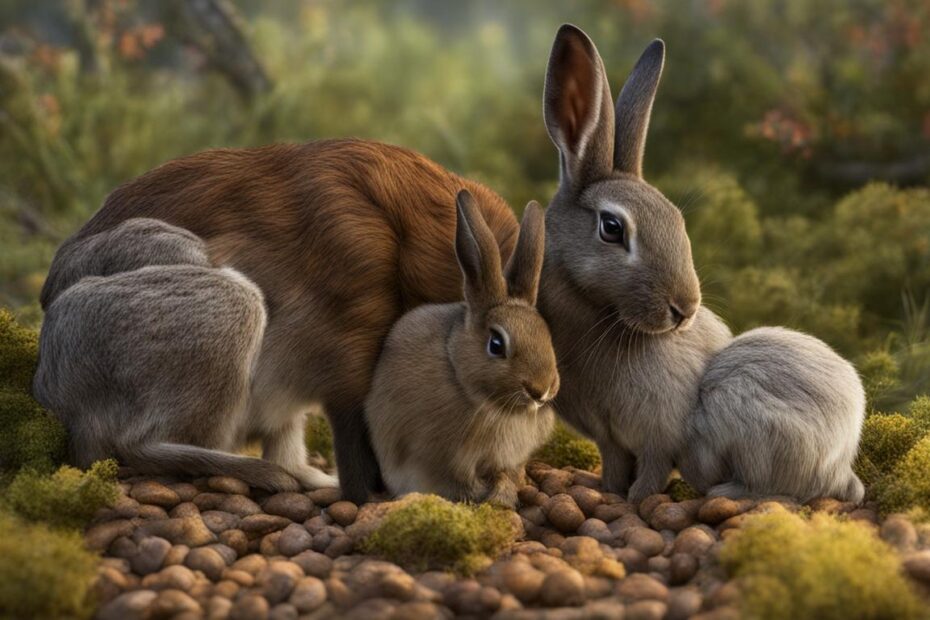Spotting the differences between rabbit scat and deer scat is essential for wilderness navigation and animal tracking. By comparing their size, color, shape, and texture, you can easily identify which animal is nearby. Deer droppings are approximately 1/2 to 5/8 inches long, black or dark brown in color, oval or cylindrical in shape, smooth in texture, and have a mild smell. On the other hand, rabbit scat is around 1/4 to 3/8 inches in diameter, light brown to dark brown in color, round or spherical in shape, hard and dry in texture, and has little to no smell. These distinct characteristics will help you differentiate between rabbit scat and deer scat in the wilderness.
Key Takeaways:
- Rabbit scat and deer scat can be differentiated by their size, color, shape, and texture.
- Deer droppings are larger, black or dark brown, oval or cylindrical, smooth, and have a mild smell.
- Rabbit scat is smaller, light brown to dark brown, round or spherical, hard and dry, and has little to no smell.
- Identifying scat is important for wilderness navigation, animal tracking, and hunting.
- Knowing how to distinguish between rabbit scat and deer scat enhances your overall experience in nature.
Understanding the Importance of Identifying Scat
Identifying animal droppings, or scat, is an essential skill for wilderness navigation, animal tracking, and wildlife identification. By being able to differentiate between rabbit scat and deer scat, you can gather valuable information about the animals present in a specific area. This knowledge is particularly valuable for hunters who are tracking game or individuals who simply want to enhance their overall experience in nature.
Being able to identify scat accurately allows hunters to track specific game animals and increase their chances of a successful hunt. By analyzing the size, color, shape, and texture of scat, hunters can determine which animals have passed through an area and follow their tracks accordingly. It also provides insights into the diversity of wildlife in the surroundings, allowing individuals to appreciate and understand the natural environment better.
In addition to hunting and wildlife enthusiasts, identifying scat is also important for wilderness navigation. By recognizing the unique characteristics of rabbit scat and deer scat, hikers and outdoor adventurers can determine if they are on the right track or if they need to reassess their route. Scat can act as a trail marker, indicating the presence of certain animals and helping individuals stay on course during their wilderness exploration.
Overall, the ability to identify scat accurately is a valuable skill for anyone venturing into the wilderness. It enhances wildlife tracking, hunting experiences, and overall understanding of the natural world. By paying attention to the size, color, shape, and texture of scat, individuals can gather valuable insights about the animal kingdom and connect with nature on a deeper level.
Size Matters: Comparing Rabbit Scat and Deer Scat
When it comes to identifying animal droppings in the wilderness, one of the key factors to consider is the size of the scat. By comparing the size of rabbit scat and deer scat, you can gain valuable insights into the animals that have been in the area. Deer droppings are generally larger, ranging from 1/2 to 5/8 inches in length. On the other hand, rabbit scat is smaller, measuring around 1/4 to 3/8 inches in diameter. This noticeable difference in size can help you quickly determine whether you’re dealing with rabbit or deer droppings.
To further enhance your understanding, let’s take a closer look at the size comparison of rabbit scat and deer scat:
| Rabbit Scat | Deer Scat |
|---|---|
| Size: 1/4 to 3/8 inches in diameter | Size: 1/2 to 5/8 inches in length |
By referencing this table, you can easily distinguish between the size of rabbit scat and deer scat, aiding in accurate wildlife identification and tracking.
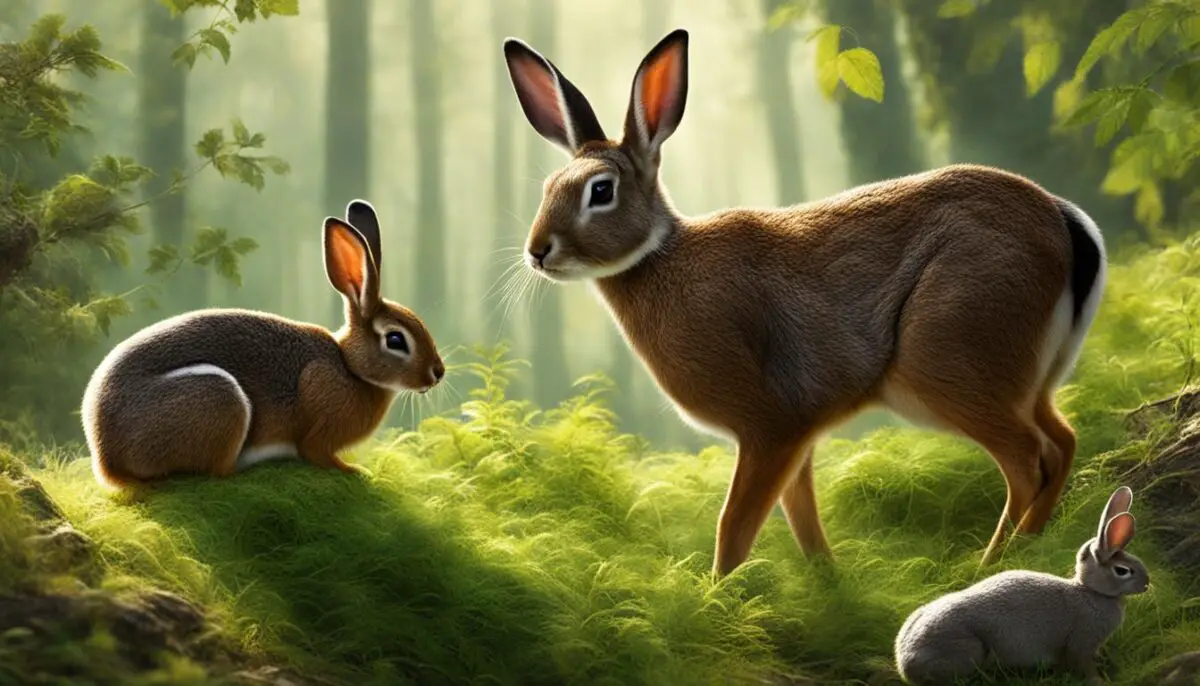
Additional Insights
It’s important to note that the size of the scat can vary depending on factors such as the animal’s age, diet, and individual variations. However, the provided size ranges offer a general guideline for differentiating between rabbit scat and deer scat in the field. By combining the analysis of size with other characteristics such as color, shape, and texture, you can further confirm your identification and gain a deeper understanding of the wildlife in your surroundings.
Distinguishing Rabbit Scat and Deer Scat: Understanding the Color Clues
When it comes to differentiating between rabbit scat and deer scat, one important factor to consider is their color. The color of the scat can provide valuable clues to help identify which animal left it behind. Deer droppings are typically black or dark brown, while rabbit scat ranges from light brown to dark brown. However, it’s worth noting that the color of the scat can vary depending on the animal’s diet. For instance, if a rabbit has consumed darker berries, its scat may appear darker in color.
While the color of the scat alone may not be sufficient to conclusively identify the animal, it can be a useful initial marker. By considering the color along with other distinguishing characteristics, such as size, shape, and texture, you can build a more complete picture and confidently identify whether it belongs to a rabbit or a deer.
Comparing the Color of Rabbit Scat and Deer Scat
| Characteristic | Rabbit Scat | Deer Scat |
|---|---|---|
| Color | Light brown to dark brown | Black or dark brown |
| Size | Around 1/4 to 3/8 inches in diameter | Approximately 1/2 to 5/8 inches long |
| Shape | Round or spherical | Oval or cylindrical |
| Texture | Hard and dry | Smooth |
By using these visual cues to compare the color and other characteristics, you can become proficient in differentiating between rabbit scat and deer scat. Remember to consider all the factors together rather than relying solely on a single characteristic. The more you practice and familiarize yourself with these distinctions, the more confident you will become in identifying animal droppings in the wilderness.
Shape Shifters: Identifying Rabbit Scat and Deer Scat by Shape
When it comes to differentiating between rabbit scat and deer scat, examining the shape of the droppings provides valuable insights. Deer scat typically takes on an oval or cylindrical shape and is often found in clustered formations. In contrast, rabbit scat is round or spherical and is usually seen as separate pellets. The distinct difference in shape can help you accurately identify whether the droppings belong to a rabbit or a deer.
“The shape of the scat is like a fingerprint, unique to each animal,” says wildlife expert Jane Smith.
“By understanding the characteristic shapes of rabbit scat and deer scat, you can gain a deeper understanding of the wildlife in your area and track their movements more effectively.”
By observing the shape of the scat, you can also gain insights into the animal’s diet. Deer scat has a more uniform shape, resembling small black or dark brown marbles, whereas rabbit scat tends to maintain its cylindrical shape and can be much skinnier than deer scat. This variation in shape is influenced by the digestive processes of each animal and the characteristics of their respective digestive tracts.
Comparing the Shape of Rabbit Scat and Deer Scat
| Animal | Shape | Characteristics |
|---|---|---|
| Rabbit | Round or spherical pellets | Skinny and cylindrical |
| Deer | Oval or cylindrical clusters | Uniform and robust |
Table: Comparison of the shape of rabbit scat and deer scat.
Understanding the shape of the scat can be an essential skill for wildlife enthusiasts, hunters, and nature lovers. By recognizing the unique shapes of rabbit scat and deer scat, you can identify the presence of these animals in the area and gain a deeper appreciation for the diverse wildlife that surrounds you.
Texture Tales: Contrasting Rabbit Scat and Deer Scat Textures
When it comes to identifying rabbit scat and deer scat, paying attention to their textures can provide valuable insights. Rabbit scat typically has a softer, crumbly texture. It breaks apart easily when touched and may feel dry and powdery. On the other hand, deer scat has a harder and denser texture. It feels more solid and compact, making it less prone to crumbling.
The difference in texture between rabbit scat and deer scat can be attributed to their digestive systems. Rabbits have a less robust digestive tract, resulting in a softer and less processed stool. In contrast, deer have a more efficient digestive system that breaks down food more effectively, creating denser droppings.
“The texture of the scat can provide important clues when distinguishing between rabbit scat and deer scat. Rabbit scat has a softer, crumbly texture, while deer scat is harder and denser.”
Identifying the texture of the scat can be especially useful when other characteristics, such as size or color, are less discernible. By running your fingers through the scat and observing the way it breaks apart, you can gather additional information to differentiate between rabbit scat and deer scat in the wilderness.
An Overview of Rabbit Scat and Deer Scat Textures
| Characteristics | Rabbit Scat | Deer Scat |
|---|---|---|
| Texture | Soft and crumbly | Hard and dense |
| Consistency | Dry and powdery | Solid and compact |
| Breakability | Easily breaks apart | Less prone to crumbling |
The table above summarizes the distinctive textures of rabbit scat and deer scat. By comparing these characteristics, you can confidently differentiate between the two types of scat and gain a better understanding of the wildlife in your surroundings. Remember to consider other factors, such as size, color, shape, and smell, to further refine your identification skills.
Distinguishing Rabbit Scat and Deer Scat: Analyzing Scat Characteristics
When it comes to tracking wildlife in the wilderness, being able to identify animal droppings is an essential skill. In this section, we will take a closer look at the characteristics of rabbit scat and deer scat to help you differentiate between the two.
Size
Rabbit scat and deer scat differ in size, which can be a key factor in identification. Rabbit scat is smaller, measuring around 1/4 to 3/8 inches in diameter, while deer scat is larger, ranging from 1/2 to 5/8 inches in length. By comparing the size of the scat you find, you can begin to narrow down which animal it belongs to.
Color
The color of the scat can also provide valuable clues. Deer scat is typically black or dark brown, while rabbit scat varies from light brown to dark brown. However, it’s important to note that the color of the scat can be influenced by the animal’s diet, so variations may occur.
Shape and Texture
Examining the shape and texture of the scat can further aid in identification. Deer scat is oval or cylindrical in shape and often clustered together, resembling small marbles. Rabbit scat, on the other hand, is round or spherical and usually separate. In terms of texture, rabbit scat has a soft, crumbly consistency, while deer scat is harder and denser.
| Characteristics | Rabbit Scat | Deer Scat |
|---|---|---|
| Size | 1/4 to 3/8 inches in diameter | 1/2 to 5/8 inches in length |
| Color | Variations of light brown to dark brown | Black or dark brown |
| Shape | Round or spherical | Oval or cylindrical |
| Texture | Soft and crumbly | Hard and dense |
By analyzing these characteristics – size, color, shape, and texture – you can confidently differentiate between rabbit scat and deer scat, enabling you to better understand the wildlife in your surroundings and enhance your tracking skills.
Mistaken Identity: Can Rabbit Scat be Confused with Deer Scat?
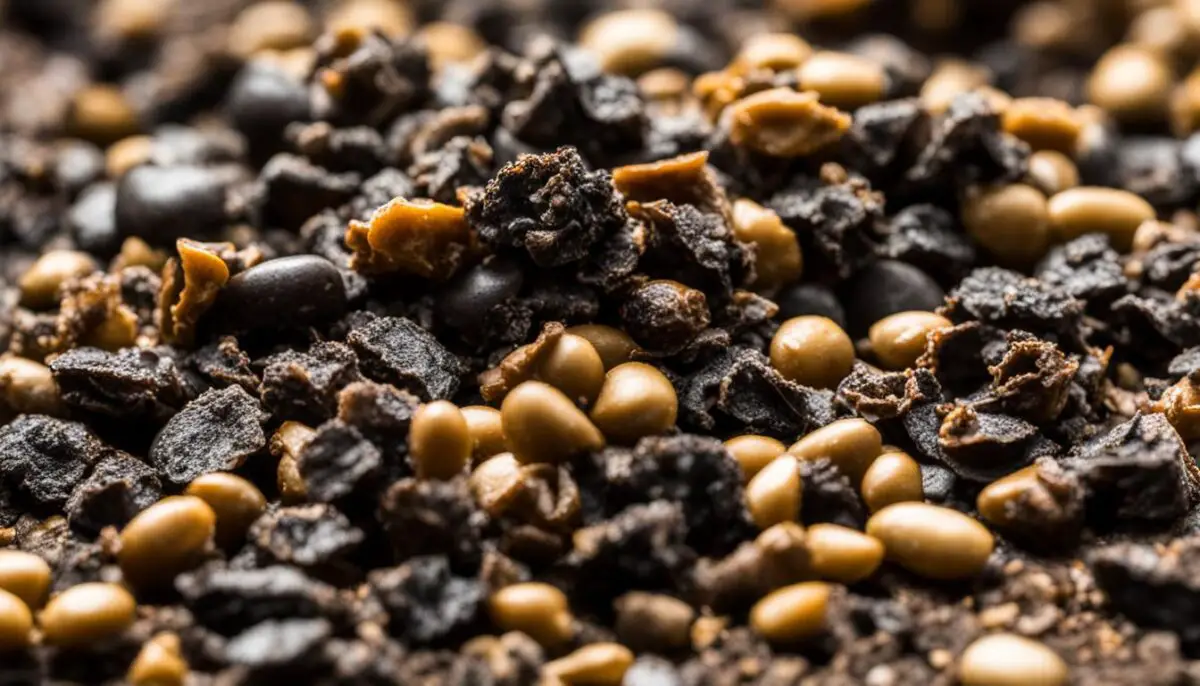
Despite the distinctive characteristics of rabbit scat and deer scat, there is still a possibility of mistaking one for the other, especially from a distance. The similarities in size, color, and shape can cause confusion, making it important to take a closer look and analyze additional features to correctly identify the scat.
“It’s easy to mistake rabbit scat for deer scat because they both share similar size and color. However, upon closer inspection, you can differentiate them by examining the texture and overall characteristics,” says wildlife expert, Dr. Jane Collins.
While rabbit scat is generally smaller and rounder, deer scat is larger and has an oval or cylindrical shape. It is crucial to consider the texture as well, as rabbit scat tends to be softer and crumbly, while deer scat is harder and denser. By paying attention to these distinguishing features, you can avoid tracking the wrong animal and accurately identify whether the scat belongs to a rabbit or a deer.
Table: Differentiating Rabbit Scat and Deer Scat
| Feature | Rabbit Scat | Deer Scat |
|---|---|---|
| Size | Smaller (around 1/4 to 3/8 inches in diameter) | Larger (approximately 1/2 to 5/8 inches long) |
| Color | Light brown to dark brown | Black or dark brown |
| Shape | Round or spherical | Oval or cylindrical |
| Texture | Soft and crumbly | Hard and dense |
While mistaking rabbit scat for deer scat is possible, a careful examination of the scat’s size, texture, and other distinguishing features can help ensure accurate identification. By utilizing these techniques, you can confidently differentiate between rabbit scat and deer scat, enhancing your wildlife tracking skills and understanding.
Comparing Rabbit Scat, Deer Scat, and Squirrel Poop
When it comes to differentiating animal droppings, understanding the distinctions between rabbit scat, deer scat, and squirrel poop is essential for accurate wildlife identification. While we have already explored the characteristics of rabbit scat and deer scat, it’s equally important to recognize the unique features of squirrel poop.
Squirrel poop can be easily distinguished from both rabbit scat and deer scat due to its smaller size and elongated shape, resembling that of rat or mouse poop. It is substantially smaller than the droppings of rabbits and deer, often measuring around 1/8 inch in length. The coloring and texture of squirrel poop also differ, primarily due to their diet, which mainly consists of nuts. Squirrel poop tends to be dark brown or black in color, with a smooth and cylindrical texture.
To summarize, differentiating between rabbit scat, deer scat, and squirrel poop is crucial for accurately identifying wildlife feces. While rabbit scat is characterized by its smaller size, light brown color, round shape, and crumbly texture, deer scat stands out with its larger size, dark brown or black color, oval shape, and harder texture. Squirrel poop, on the other hand, is distinguished by its smaller size, elongated shape, dark brown or black color, and smooth texture.
| Animal | Size | Color | Shape | Texture |
|---|---|---|---|---|
| Rabbit Scat | 1/4 to 3/8 inches in diameter | Light brown to dark brown | Round or spherical | Hard and dry, crumbly |
| Deer Scat | 1/2 to 5/8 inches long | Black or dark brown | Oval or cylindrical | Smooth |
| Squirrel Poop | Approximately 1/8 inch long | Dark brown or black | Elongated | Smooth and cylindrical |
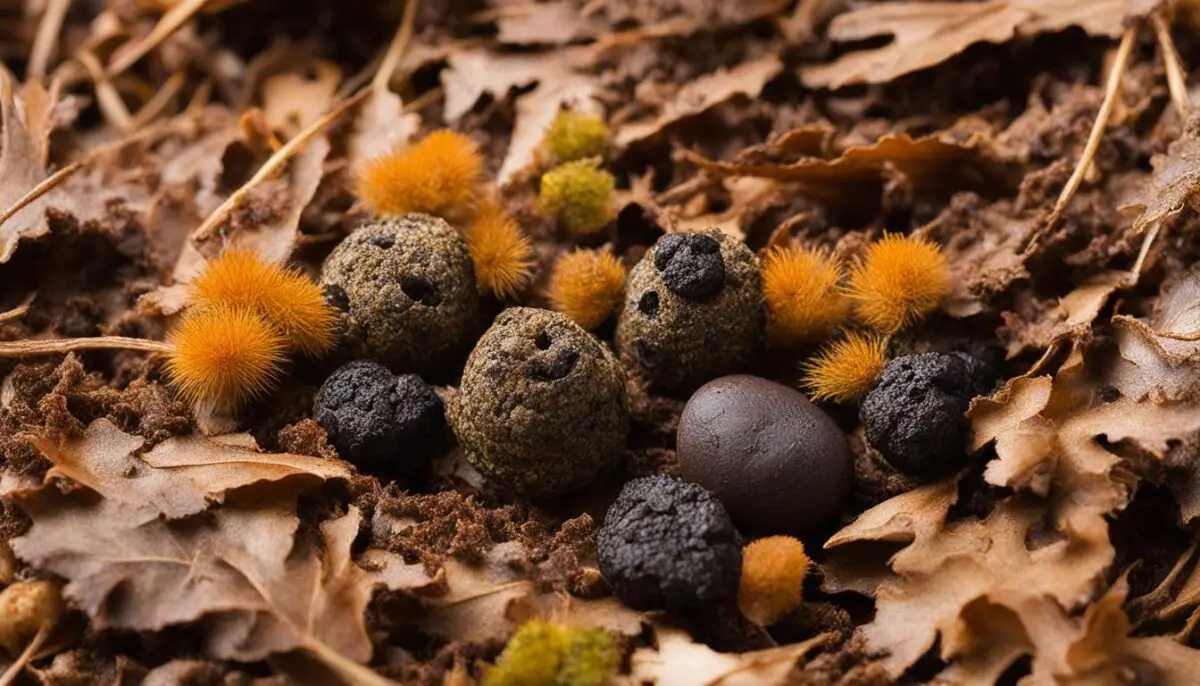
The Art of Tracking: How to Identify Rabbit Scat and Deer Scat
When it comes to animal tracking, being able to identify rabbit scat and deer scat is a valuable skill. By understanding the distinguishing characteristics of each, you can accurately track and hunt specific game animals, enhancing your overall tracking experience.
Size and Color
One of the key factors to consider when identifying scat is size. Deer scat is generally larger, while rabbit scat is smaller and more compact. Table 1 provides a comparison of the average sizes of rabbit scat and deer scat. Additionally, the color of the scat can offer clues about the animal that left it behind. Deer scat is often black or dark brown, whereas rabbit scat is lighter in color, ranging from light brown to dark brown.
| Animal | Average Size |
|---|---|
| Rabbit | 1/4 to 3/8 inches in diameter |
| Deer | 1/2 to 5/8 inches in length |
Shape and Texture
The shape and texture of scat can also provide valuable insights for tracking. Deer scat is typically oval or cylindrical in shape, often clustered together along game trails. Rabbit scat, on the other hand, is round or spherical and usually found as individual pellets. In terms of texture, deer scat is harder and denser, while rabbit scat is softer and crumbly. Table 2 summarizes these differences in shape and texture.
| Animal | Shape | Texture |
|---|---|---|
| Rabbit | Round or spherical | Soft and crumbly |
| Deer | Oval or cylindrical | Hard and dense |
Scat Identification Techniques
When tracking animals in the wild, it’s essential to employ various techniques to identify scat accurately. Here are a few tips to help you become proficient in scat identification:
- Take note of the size and color of the scat to distinguish between rabbit scat and deer scat.
- Observe the shape and texture of the scat to further narrow down your identification.
- Pay attention to the location of the scat; deer scat is often found along game trails, while rabbit scat is more scattered.
By combining these techniques, you can confidently identify rabbit scat and deer scat during your tracking adventures.
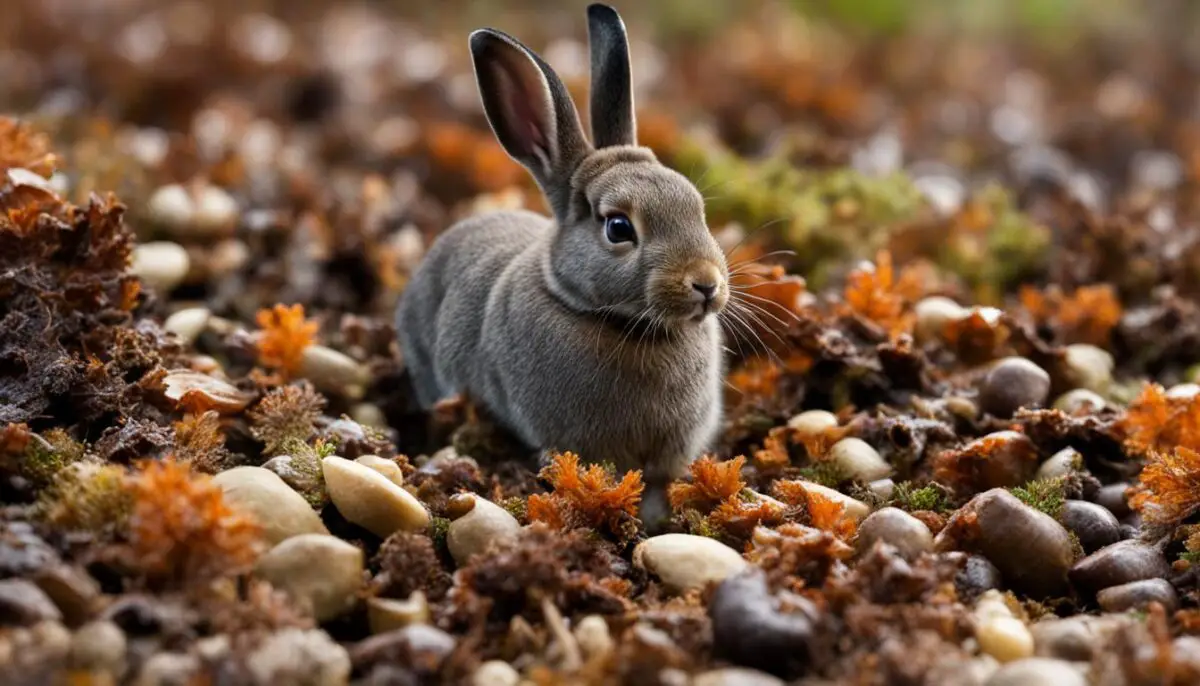
Conclusion
Distinguishing between rabbit scat and deer scat is essential for wilderness navigation, animal tracking, and hunting. By understanding the differences in size, color, shape, and texture, you can accurately identify which animal has been in a particular area.
Rabbit scat, with its smaller size, light brown color, round shape, and crumbly texture, can be easily differentiated from deer scat. Deer scat, on the other hand, is larger, darker in color, oval in shape, and has a harder texture.
By being familiar with these distinct characteristics, you can confidently identify and analyze animal droppings in the wilderness, enhancing your understanding of wildlife behavior and improving your overall outdoor experience.
FAQ
Are there any noticeable differences between rabbit scat and deer scat?
Yes, there are distinct differences in size, color, shape, and texture between rabbit scat and deer scat.
How can I differentiate between rabbit scat and deer scat?
By comparing their size, color, shape, and texture, you can easily identify which animal is nearby.
What is the size of deer droppings compared to rabbit scat?
Deer droppings are approximately 1/2 to 5/8 inches long, while rabbit scat is around 1/4 to 3/8 inches in diameter.
How can I distinguish the color of rabbit scat from deer scat?
Deer droppings are typically black or dark brown, while rabbit scat ranges from light brown to dark brown.
What are the typical shapes of deer droppings and rabbit scat?
Deer droppings are oval or cylindrical in shape, often clustered together, while rabbit scat is round or spherical and usually separate.
How does the texture of rabbit scat differ from deer scat?
Rabbit scat has a softer, crumbly texture, while deer scat is harder and denser.
Can rabbit scat be easily confused with deer scat?
While there may be similarities in size, color, and shape, a closer inspection of the scat’s characteristics can help differentiate between the two.
How does squirrel poop differ from rabbit scat and deer scat?
Squirrel poop is smaller, elongated in shape, and has different coloring and texture due to their diet primarily consisting of nuts.
Why is it important to accurately identify rabbit scat and deer scat?
Accurate identification helps with wilderness navigation, animal tracking, hunting, and understanding the diversity of wildlife in an area.
What techniques can I use to identify rabbit scat and deer scat?
By carefully examining the size, color, shape, and texture of the scat, you can identify whether it belongs to a rabbit or a deer.


